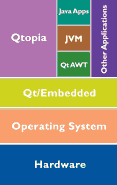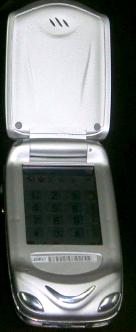Trolltech aims Linux/Qtopia at mobile phone market
Oct 31, 1997 — by LinuxDevices Staff — from the LinuxDevices Archive — 3 views Like The Little Engine That Could, tiny Oslo-based Trolltech today unveiled a Linux-based challenge to Symbian's and Microsoft's domination of the rapidly… expanding mobile phone market. The 80-person company announced that it has customized its Qtopia mobile device application stack — essentially the same application environment used by Sharp in its Linux-based Zaurus PDAs — for use in next-generation Linux-based mobile phones.
Like The Little Engine That Could, tiny Oslo-based Trolltech today unveiled a Linux-based challenge to Symbian's and Microsoft's domination of the rapidly… expanding mobile phone market. The 80-person company announced that it has customized its Qtopia mobile device application stack — essentially the same application environment used by Sharp in its Linux-based Zaurus PDAs — for use in next-generation Linux-based mobile phones.
Motorola, the number two maker of mobile phones (“handsets”) with an estimated worldwide market share of 19 percent, announced the first Linux-based handset from a major manufacturer earlier this year. Motorola's A760 combines the functions of a mobile phone, PDA, digital camera, video player, MP3 player, speakerphone, messaging, Internet access, and Bluetooth wireless technology. But like Sharp with its Linux-based Zaurus fighting against a market ruled by Palm and Microsoft, Motorola's Linux-based A760 remains a solaritary voice in a market dominated by Symbian and Microsoft.
Trolltech aims to change that, with its release today of a complete application software stack tuned to the requirements of the mobile phone market. Although the company's Qtopia Phone Edition won't be formally released until Q1 2004, Trolltech CEO Haavard Nord says his company has already delivered pre-release versions of the software to a handful of device makers who are working on Linux-based mobile phones for production release during the first half of 2004.
Handheld market trends
Trolltech's strategy of moving Qtopia beyond PDAs — to mobile phones — appears sound, given the realities of the current handheld market, as indicated by analyst research projecting a bright future for camera phones and other “feature phones” at the same time the PDA market is experiencing stagnation.
Research from Future Image's Wireless Imaging information service finds that in 2003, 50 million phones with cameras will reach consumers, along with 40 million phones with camera attachments. Yet despite growth in the handheld market generally, PDA shipments are in decline, according to a recent report from IDC, which suggests that future growth in the PDA market will depend on the development of “converged mobile devices” — voice-enabled devices that combine the data capabilities of PDAs with the voice communication capabilities of mobile phones.
Less is more
Nord says Qtopia Phone Edition offers all the functionality required in high-end, PDA-like smartphones. However, Nord says, Trolltech is primarily hoping for traction in the mid-range “feature-phone” market which, he says, is a much higher volume market than that for smartphones.
Feature-phones are mid-range products which combine mobile phone service with features such as a camera and/or email. They typically boot from 8MB of Flash memory. High-end smartphones, on the other hand, typically boot from 16MB or more of Flash and add a full set of PDA features including PIMS (personal information management suit), productivity, multimedia, networking, email, and web browsing. Smartphones also typically have touch-screens for stylus input, whereas feature-phones are generally limited to a set of standard mobile phone buttons for user input.
Nord says the Linux/Qtopia combo will be successful in this market because it is more resource-friendly than software stacks from either Symbian or Microsoft. In fact, he claims the Linux/Qtopia combo can deliver smartphone capabilities on feature-phone level hardware — something he says neither Symbian nor Microsoft can offer — with the result that device makers are evaulating the Linux/Qtopia combo as a way to offer smartphone features at feature-phone prices, and thus gain greater share of the booming mobile phone market.
“Linux with Qtopia Phone Edition can run on less expensive hardware,” explains Nord. “Linux will therefore run on both mid-end camera phones in addition to smartphones. Linux feature-phones will basically have the same apps and functionality as the more expensive smartphones.
“[Device makers] will have much higher shipments than if they're only making smartphones,” continues Nord. “A few hundred thousand phones per year doesn't generate lots of revenue, millions of phones do. I expect Linux to ship on more phones than Symbian and Microsoft combined in 2-3 years.”
Hogne Tjemsland, product manager of Qtopia and Qt/Embedded, elaborates on the resource considerations: “The minimal Qtopia Phone Edition is currently 5.3MB on a compressed cramfs filesystem. This includes all applications and libraries (PIMs, games, multimedia, messages, settings, phone apps, Qt/Embedded, . . . ) linked as a single executable build (still running programs as separate Unix processes). The media player is fairly large due to the ffmpeg library. It consumes around 800KB (compressed). By optimizing this library for embedded systems or replacing it with a commercial library we expect the full Qtopia to be around 5MB compressed. Thus, we expect Linux plus Qtopia to fit well in 8MB of Flash and still leave room for more applications and a Java virtual machine.”
Trolltech will also offer a dynamical build of Qtopia Phone Edition targeting systems with 16MB flash configuration, according to Tjemsland.
 What does Qtopia Phone Edition offer?
What does Qtopia Phone Edition offer?
Basically, Trolltech says Qtopia Phone Edition includes all the standard Qtopia applications, adapted to fit a mobile handset user interface. For example, all user inputs that would be made via touch-stylus or handwriting recognition are remapped to a typical mobile phone button-set.
Trolltech provided the following screenshots from a pre-release snapshot of Qtopia Phone Edition.
In addition to standard Qtopia apps, Qtopia Phone Edition includes a new “Home” application (shown in the above handset simulation screenshot) that displays time-critical data about missed calls, messages received, and calendar events. It features a customizable background and color schemes, and users can add reminders and to-do items.
Qtopia Phone Edition can synchronize with either Microsoft Outlook or Qtopia Desktop, a free desktop PIM suite from Trolltech available for Linux, MacOS X, and Windows. Sync capability extends to contacts, calendar events, to-do items, as well as multimedia files and documents, according to Trolltech.
Qtopia Phone Edition will be available with stylus and/or keypad support, and with support for 240 x 320 or 176 x 208 resolution. It can be personalized by end users, and customized by manufacturers and network operators, the company claims.
Telephone toolbox
Qtopia Phone Edition shares a common development environment with Qtopia, and both are based on the Qt/Embedded application framework. This commonality means that Trolltech's existing development tools for Qtopia can be used with Qtopia Phone Edition. Additionally, it suggests that existing Qtopia applications — there are “thousands,” according to Trolltech — will port easily to Qtopia Phone Edition.

Qtopia and Qtopia Phone Edition share a common architecture
Trolltech considers Qtopia “the de facto standard application platform for embedded Linux,” and it certainly is true that Qtopia sees wide use, especially on PDAs such as Sharp's Zaurus line, Royal's LineaLX, and Softfield's MX-7. IBM also licensesd Qtopia for use in its handheld reference designs.
Sharp's Zaurus, in particular, has spawned a robust third-party software community, with Qtopia-based Zaurus downloads offered at sites such as Zaurus Software Index, ZaurusZone.com, and pdaPointer, among others.
“Qtopia Phone Edition is the first solution in the market to offer a completely extendable platform for Linux-based mobile computing devices,” asserts Nord. “Qtopia Phone Edition provides unprecedented functionality as an out-of-box solution and can be easily extended and customized.”
The Java connection
Few features are as important to device developers today as Java support. Trolltech reports that several Java Virtual Machines are already running on Qtopia Phone Edition, including Esmertec's Jeode and IBM's VisualAge Micro Edition. Trolltech claims that Java applications integrate seamlessly with Qtopia Phone Edition, providing a native look and feel, an important consideration for phone makers and service providers.
Recent market research from Venture Development Corp (VDC) confirms the importance of Java support in new consumer and mobile devices. Chris Lanfear, manager of VDC's Embedded Software Research Group, notes that “Most mid-range and high-end mobile phones include an application environment. That environment is overwhelmingly Java based.”
 Early adopters
Early adopters
Nord wrote to LinuxDevices.com during a recent trip to Asia, where he met with several early customers. “We're doing a pre-release (with source) to customers, and some of them will use it to start developing their phone software.”
Asked if he could mention any specific company names, Mr. Nord cited “Foxconn, the biggest ODM [original design manufacturer] in Taiwan. They're coming out with a Qtopia Phone Edition in Q1 next year. [It will be a] very nice phone for the high volume mid-end market. Less expensive than the Motorola phone. We're also working with several companies in Asia building phones with Qtopia, but these are under NDA [non-disclosure agreements] for now. One of them is a 3G phone for China.”
In a related announcement, Trolltech reports that the application stack in Motorola's much-anticipated A-760 Linux phone is based on Qt/Embedded, the software framework underlying Qtopia Phone Edition. However, the A-760 does not use Qtopia Phone Edition itself.
This article was originally published on LinuxDevices.com and has been donated to the open source community by QuinStreet Inc. Please visit LinuxToday.com for up-to-date news and articles about Linux and open source.